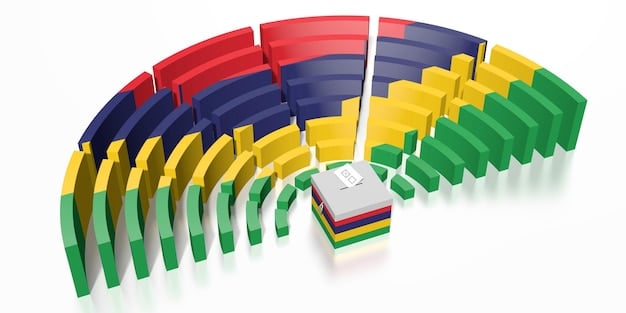REIT Dividend Sustainability: Evaluating Payout Reliability

REIT dividend sustainability hinges on evaluating payout ratios and cash flow, ensuring long-term reliability for investors by analyzing financial health and market conditions of US Real Estate Investment Trusts.
For investors drawn to the steady income stream that Real Estate Investment Trusts (REITs) can provide, understanding **REIT dividend sustainability: evaluating payout ratios and cash flow to determine long-term dividend reliability for US REITs** is paramount. After all, a high yield is enticing, but only if it’s built on a solid financial foundation.
Understanding REIT Dividend Sustainability
REITs, or Real Estate Investment Trusts, are known for their attractive dividends. To ensure these dividends continue, it’s crucial to assess their sustainability. This involves looking at various financial metrics that indicate the REIT’s ability to maintain its payouts over the long term.
Key Metrics for Assessing Sustainability
Several key metrics can help investors gauge the sustainability of REIT dividends. These metrics offer insights into the REIT’s financial health and its capacity to meet its dividend obligations.
- Payout Ratio: This ratio indicates the proportion of earnings paid out as dividends. A high payout ratio may signal potential unsustainability if earnings decline.
- Cash Flow: Monitoring cash flow, particularly Funds From Operations (FFO) and Adjusted Funds From Operations (AFFO), provides a clearer picture of the REIT’s ability to cover dividends.
- Debt Levels: High debt levels can strain a REIT’s finances, potentially impacting its ability to sustain dividends.
Investors should analyze these metrics in conjunction to gain a comprehensive understanding of a REIT’s dividend sustainability. A single metric in isolation might not provide an accurate picture.
Evaluating Payout Ratios for REITs
The payout ratio is a critical indicator of dividend sustainability. It shows how much of a REIT’s earnings are being distributed as dividends. Analyzing this ratio helps determine if the dividend payments are reasonable relative to the company’s earnings.
Calculating the Payout Ratio
The payout ratio is calculated by dividing the total dividends paid by the REIT’s earnings. However, for REITs, it’s more insightful to use Funds From Operations (FFO) instead of net income. FFO is a measure of a REIT’s cash-generating ability.
Payout Ratio = Total Dividends Paid / Funds From Operations (FFO)

A lower payout ratio suggests that the REIT has more cushion to maintain dividends, even if earnings decline. Conversely, a high payout ratio indicates that the REIT is distributing a large portion of its earnings, leaving less room for error.
Interpreting Payout Ratios
Generally, a payout ratio below 80% is considered sustainable for REITs. Ratios above this level may warrant closer scrutiny. However, it’s essential to consider the specific REIT’s circumstances and industry trends.
Payout ratios should be evaluated over several years to identify trends. A rising payout ratio could signal that dividends are becoming less sustainable, while a stable or declining ratio is generally a positive sign.
Understanding how to calculate and interpret payout ratios provides a valuable tool for assessing the sustainability of REIT dividends. This metric, when combined with other financial indicators, helps investors make informed decisions.
Assessing Cash Flow for Dividend Reliability
Cash flow is the lifeblood of any company, and REITs are no exception. Evaluating a REIT’s cash flow provides a direct view of its ability to fund its dividend payments. Analyzing Funds From Operations (FFO) and Adjusted Funds From Operations (AFFO) is crucial.
Understanding FFO and AFFO
FFO, or Funds From Operations, is a key metric used to measure a REIT’s operating performance. It adjusts net income to exclude gains and losses from property sales and depreciation, providing a more accurate picture of cash generated from operations.
Adjusted Funds From Operations (AFFO) takes FFO a step further by accounting for recurring capital expenditures and other non-cash items. AFFO is often considered a more conservative measure of cash flow available for dividends.
Cash Flow Coverage Ratio
The cash flow coverage ratio is calculated by dividing FFO or AFFO by the total dividends paid. This ratio indicates how well the REIT’s cash flow covers its dividend obligations. A higher ratio suggests greater dividend sustainability.
- High Coverage Ratio: A ratio above 1.0 indicates that the REIT generates enough cash to cover its dividends comfortably.
- Low Coverage Ratio: A ratio below 1.0 may signal that the REIT is using debt or asset sales to fund its dividends, which is not sustainable in the long term.
- Ideal Range: A coverage ratio between 1.2 and 1.5 is generally considered healthy for REITs.
When evaluating cash flow, investors should also consider the stability and predictability of the REIT’s cash flows. Consistent and growing cash flows are more indicative of long-term dividend reliability. Monitoring FFO and AFFO trends over time provides valuable insights into a REIT’s financial health.
The Impact of Debt on Dividend Sustainability

Debt levels play a significant role in a REIT’s ability to sustain its dividends. High levels of debt can strain a REIT’s finances and reduce the cash available for dividend payments. Understanding how to assess a REIT’s debt is essential for evaluating dividend sustainability.
Key Debt Metrics to Consider
Several debt metrics can provide insights into a REIT’s financial leverage and its ability to manage debt. These metrics include:
Debt-to-Asset Ratio: This ratio measures the proportion of a REIT’s assets financed by debt. A high ratio indicates greater financial risk.
Debt-to-Equity Ratio: This ratio compares a REIT’s total debt to its shareholders’ equity. A high ratio suggests that the REIT relies heavily on debt financing.
Interest Coverage Ratio: This ratio measures a REIT’s ability to cover its interest expenses with its operating income. A low ratio indicates that the REIT may struggle to meet its debt obligations.
The weighted average debt maturity profile of a REIT is also an important consideration. A REIT with very short-dated debt maturity carries refinancing risk that it won’t be able to meet its obligations when the debt becomes due. Refinancing may mean a REIT has to sell off assets to decrease their debt burden, a situation that would not favor dividend sustainability.
Analyzing Debt Levels and Dividend Risk
High debt levels can increase the risk of dividend cuts. When a REIT has significant debt obligations, it may prioritize debt repayment over dividend payments, especially during economic downturns. REITs that are highly leveraged may find it difficult to maintain dividends when property values decline or vacancy rates rise.
Investors should look for REITs with reasonable debt levels and strong interest coverage ratios. A well-managed REIT will have a diversified debt portfolio with staggered maturities, reducing refinancing risk. Analyzing a REIT’s debt profile is critical for assessing the long-term sustainability of its dividends.
Ultimately, understanding a REIT’s debt relative to its equity, assets, and income from operations is as important in calculating sustainability as the other factors discussed. Any consideration to sustainability should carefully analyze a REIT’s approach to credit and the obligations it has as a result.
External Factors Affecting REIT Dividends
Beyond internal financial metrics, external factors can significantly impact a REIT’s ability to sustain its dividends. Economic conditions, interest rates, and market trends all play a role in determining dividend reliability. Understanding these external influences is crucial for investors.
Economic Conditions and Real Estate Market
Economic downturns can negatively affect REITs. During recessions, property values may decline, vacancy rates may increase, and rental income may decrease. These factors can reduce a REIT’s cash flow and its ability to maintain dividend payments.
Changes in interest rates can also impact REITs. Rising interest rates can increase borrowing costs, reducing the cash available for dividends. Conversely, falling interest rates can boost REIT profitability.
Market Trends and Sector Performance
Market trends and sector-specific performance can influence REIT dividends. For example, certain property sectors, such as healthcare or industrial, may perform better during certain economic conditions.
- Healthcare REITs: These REITs tend to be more resilient during economic downturns due to the essential nature of healthcare services.
- Retail REITs: These REITs are more sensitive to economic conditions and consumer spending patterns.
- Office REITs: Demand, use and revenue are driven by the needs and location of companies, which in turn are subject to the economy overall.
Investors should monitor these external factors and consider their potential impact on REIT dividends. Diversifying across different property sectors can help mitigate risk and improve the overall sustainability of a REIT portfolio.
Understanding how external forces influence REIT dividends provides investors with a more comprehensive perspective on dividend reliability. By considering these factors, investors can make more informed decisions and better assess the long-term sustainability of REIT income.
Strategies for Identifying Sustainable REIT Dividends
Identifying sustainable REIT dividends requires a comprehensive approach that combines financial analysis with qualitative assessment. Investors should look for REITs with strong financial metrics, sound management, and favorable market conditions.
Conducting Due Diligence
Thorough due diligence is essential for identifying sustainable REIT dividends. This involves analyzing financial statements, reading company reports, and assessing management’s strategy.
Analyzing Financial Statements
Financial statements provide valuable information about a REIT’s financial health. Investors should pay close attention to:
- Balance Sheet: Assessing the REIT’s assets, liabilities, and equity.
- Income Statement: Evaluating revenue, expenses, and net income.
- Cash Flow Statement: Monitoring cash flow from operations, investing, and financing activities.
Qualitative Assessment
In addition to financial analysis, qualitative factors should be considered. This includes assessing the REIT’s management team, property portfolio, and competitive position.
Look for REITs with experienced and reputable management teams. A strong management team can effectively navigate economic challenges and make sound investment decisions. Also, evaluate the quality and diversification of the REIT’s property portfolio. A diversified portfolio can reduce risk and improve dividend sustainability. Finally, assess the REIT’s competitive position within its sector. A strong competitive position can help the REIT maintain occupancy rates and rental income.
Selecting REITs with sustainable dividends involves a combination of financial analysis and qualitative assessment. By conducting thorough due diligence, investors can identify REITs that are well-positioned to maintain their dividends over the long term.
| Key Metric | Brief Description |
|---|---|
| 📊 Payout Ratio | Percentage of earnings paid as dividends; lower is generally better. |
| 💸 Cash Flow (FFO/AFFO) | Indicates ability to cover dividends; higher values suggest greater sustainability. |
| debt Level | High debt can strain finances; lower debt-to-asset ratio is preferred. |
| 📈 Interest Coverage | Measures a REIT’s ability to pay the interest on its debt. |
Frequently Asked Questions (FAQ)
▼
It is the proportion of earnings that a Real Estate Investment Trust (REIT) distributes as dividends. Typically calculated as total dividends divided by funds from operations (FFO), it signals dividend sustainability.
▼
Cash flow, particularly FFO and adjusted funds from operations (AFFO), mirrors a REIT’s capacity to meet dividend commitments. Consistent cash flow often indicates stronger dividend reliability, thus being important.
▼
High levels of debt can strain a REIT’s finances, potentially decreasing its dividend sustainability. A well-managed REIT with moderate debt is generally more stable and reliable.
▼
Economic conditions, prevailing interest rates, and the real estate market trends collectively shape REIT dividends. Monitoring these factors is key for understanding potential volatility in dividend income.
▼
Investors should combine thorough due diligence with financial and qualitative metrics, such as the REIT’s financial health, experienced management, and favorable market positioning to identify.
Conclusion
In summary, evaluating **REIT dividend sustainability: evaluating payout ratios and cash flow to determine long-term dividend reliability for US REITs** requires a holistic approach. By carefully analyzing payout ratios, cash flow, debt levels, and external factors, investors can make informed decisions and select REITs that are well-positioned to provide sustainable dividend income.





